CJC-F, CJC-F Announcements, CJC-F Understanding Forensics
Blood Spatters: Messy Smears or Inconspicuous Clues?
Blood Patterns in a Crime Scene
Imagine entering a crime scene and being greeted by pools of blood as well as a mess of crimson smears on the floor where a brutal murder had taken place. On first sight, an untrained eye would dismiss the bloodshed as an unsurprising aftermath following a tragic event. However, a professional blood pattern examiner would argue otherwise and maintain that there is a story hidden among the red stains. Indeed, blood splatter and bloodstains belong to a class of pattern evidence analysis that examines and characterises blood patterns based on the intrinsic properties of blood in relation to the surroundings. The objective of bloodstain pattern analysis (BPA) is to assist the court in unravelling what had happened and in what sequence, which could be pivotal to establishing the elements of a case.
Blood and its Properties
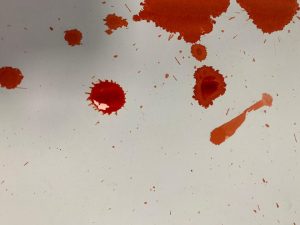
Blood is a fluid that flows in the human body and primarily responsible for the transport of oxygen and nutrients. Human blood consists of the blood plasma and various cellular material such as red and white blood cells, waste materials, antibodies and protein contents, which are essential for forensic scientists to carry out tests for to detect for the presence of blood. As it is not uncommon to encounter messy crime scenes in which blood cannot be instantly recognised and distinguished from other interferences, crime scene investigators first identify blotches of red viscous fluid, which could otherwise appear in a semi-hardened state, and conduct presumptive tests. The presumptive test used for blood works on the rationale that hemoglobin in red blood cells is able to catalyse the oxidation reaction of reagents, leading to a visible colour change. The Kastle-Meyer test (or “KM” test) is widely used as a presumptive test for blood, where a small amount of the reagent administered turns from colourless to pink in the presence of blood. Another presumptive test is the leuco-malachite green (LMG), which turns from colourless to blue-green when oxidised by blood. Such colour-change tests offer the advantages of detecting low amounts of blood sample at the crime scene and provide a quick qualitative answer for investigators to determine if the fluid found is blood. What follows are serological tests to ascertain if the blood is of human origin and this can be done by screening for the presence of proteins specific to humans or through blood or DNA typing, which additionally facilitates the identification of the owner of the blood.
Bloodstain Pattern Analysis (BPA)
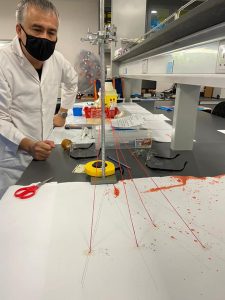
Blood splatters and bloodstains left behind in crime scenes are carefully scrutinised by crime scene investigators to unveil details of the crime. Formation of patterns are dependent on multiple factors including the type of injury, type and strength of force applied to inflict the injury, volume of blood shed, the angle at which and distance travelled by the blood as well as the texture of the surface that the blood comes into contact with, etc. According to the Scientific Working Group on Bloodstain Pattern Analysis (SWGSTAIN), bloodstain patterns may be classified as active or passive, of which the former arises due to travel of blood by force while the latter occurs under the influence of gravity. Examples of active bloodstain patterns include those that are left behind due to contact transfer such as wipes, swipes and transfer of bloodstain patterns. Projected patterns comprise of cast-offs which happen due to blood drops dispersing into the air when external force is applied to a source of blood, and impact spatter that could result from force of low to high velocity applied. Passive bloodstains may comprise of drop, drip, flow or pool that happen under undisturbed conditions.
BPA helps to establish the origin of the bloodstains, which could be from a victim or the assailant, and retrace the position or movement of the persons involved by examining the type and direction of the bloodstains or patterns observed. This is carried out so as to corroborate or contest testimonials from suspects or witnesses as well as correlate with DNA profiling or medical autopsy reports, if any. BPA can also extract information such as time of incident or time of death based on the time elapsed for a blood pool to dry or livor mortis (the settling of blood to the lowest parts of the body when natural blood circulation stops upon death).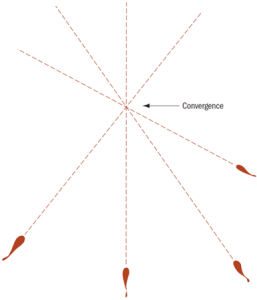
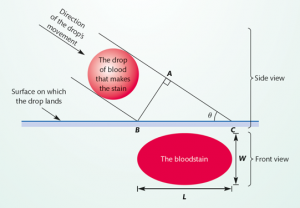
Figures 1 & 2. Determination of origin of blood splatter
BPA may provide a great deal of information regarding the source of the blood splatter by determining the 2D or 3D point of origin. The direction of each blood splatter droplet in a blood splatter is extrapolated to an area of convergence, after considering the shape of the droplet and the angle at which it impacted the surface. This is done by measuring the width and the length of the droplet followed by a trigonometric backward calculation to obtain the angle of impact.
The following examples demonstrate how blood spatter analysis helped establish the guilt of the accused.
Phua Soy Boon v PP
Facts: The defendant used a chopper to slash the victim in the neck twice, killing him. The defendant was charged with murder under s 300 of the Penal Code (“PC”). The defendant argued that he merely pressed the chopper against the victim’s neck, and that the latter had moved suddenly, causing the cuts.
Holding and explanation: Convicting the defendant of murder, the court reasoned that the blood stains found were as high as 2.2m; when compared to the victim’s height (1.60m), it was evident that the blood was thrown off a moving weapon onto the wall.
The nature of the blood stains indicated that the wounds were caused intentionally, establishing the mens rea(i.e. intention to cause injuries that were sufficient in the ordinary course of nature to cause death).
In the absence of any applicable defences (namely, sudden fight), the defendant was duly convicted of murder.
Asokan v PP
Facts: Together with an accomplice, the defendant killed the victim before placing his body in the boot of a car and setting fire to the car. The accused was charged with committing murder in furtherance of a common intention (ss 34 and 300, PC).
Holding and explanation: Convicting the defendant of murder, the court accepted the expert’s testimony that the “teardrop” shape of the blood spatters directed upwards at an angle indicated that the blood came from a cut artery (likely the carotid artery). Such an injury was sufficient in the ordinary course of nature to cause death.
Since the accused devised the plan to attack the deceased together with his accomplice, it was immaterial who inflicted the fatal injuries; the wounds were caused in furtherance of the pair’s common intention to cause grievous bodily injury. Taken with the fact that the injuries were sufficient in the ordinary course of nature to cause death, the mens rea was established.
In the absence of any applicable defences (namely, self-defence, provocation and sudden fight), the defendant was duly convicted of murder in furtherance of a common intention under ss 34 and 300 of the Penal Code.
Limitations of BPA
Bloodstain pattern analysts reconstruct, in particular, the incident which happened that led to a blood shed and the crime scene based on the information available from the blood splatter patterns present. However, BPA are interpretations made based on the blood pattern examiner’s expertise and from rigorous BPA experiments conducted. Naturally, bloodstains and blood splatters found at a crime scene are not vulnerable to alterations that arise due to moving of the victim’s body, arrival of first responders and paramedics, or even washing away of bloodstains in an attempt by the perpetrator to cover up his act. Moreover, blood patterns that are scant or complex may appear to be insufficient or complicated for interpretation to be carried out, especially if it overlaps with blood shed from other unrelated events. Therefore, it is recommended that BPA is not considered in silos but to be placed together with other corroborative facts before assigning appropriate weight to this evidence.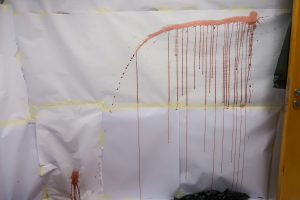
*The views and opinions expressed in this article do not constitute legal advice and solely belong to the author and do not reflect the opinions and beliefs of the NUS Criminal Justice Club or its affiliates.
References
- Andrew R. W. Jackson & Julie M. Jackson. 2017. Forensic Science, 4th Pearson.
- Richard Saferstein. 2018. Criminalistics: An Introduction to Forensic Science, 12th Pearson.
Authors’ Biography
 Associate Professor Stella Tan has postgraduate qualifications in law and science from NUS, and a postgraduate forensic science qualification from the Henry C. Lee Institute of Criminal Justice and Forensic Science, where she graduated top of her class under the tutelage of Dr Henry Lee, a renowned forensic expert in the United States of America. Prior to joining NUS in 2018 as a full-time faculty member, she was a Deputy Senior State Counsel at the Attorney-General’s Chambers where she was the lead prosecutor for a wide range of cases, including murder, sexual assault and drugs, and later Director (Prosecution and Legal Policy) at the Health Sciences Authority (HSA), where she provided legal advice and practical training to forensic experts. Prof Stella Tan is currently the Director of the Forensic Science undergraduate and postgraduate programmes at the Faculty of Science. She runs modules in both the Faculty of Law and the Faculty of Science. The modules which Prof Tan teaches are as follows: LSM1306 Forensic Science, SP3202 Evidence in Forensic Science, SP4261 Articulating Probability and Statistics in Court, SP4262 Forensic Human Identification, SP4263 Forensic Toxicology and Poisons, SP4264 Criminalistics: Evidence and Proof, SP4265 Criminalistics: Forgery Expose with Forensic Science, SP4266 Forensic Entomology, FSC5199 Research Project in Forensic Science, FSC5101 Survey of Forensic Science, FSC5201 Advanced CSI Techniques, FSC5202 Forensic Defense Science, FSC5203 Digital Forensic Investigation, FSC5204 Forensic Psychiatry and Psychology, FSC5205 Forensic Science in Major Cases and LL4362V/FSC4206 Advanced Criminal Litigation – Forensics On Trial. Prof Stella Tan is also the Principal Investigator of the NUS Forensic Science Laboratory, where her collaborators include the Massachusetts Institute of Technology, Singapore Police Force and Central Narcotics Bureau. Her interest in nurturing students has won her Dean’s Meritorious Teaching Awards as well as the Best Supervisor award for Undergraduate Research Opportunities.
Associate Professor Stella Tan has postgraduate qualifications in law and science from NUS, and a postgraduate forensic science qualification from the Henry C. Lee Institute of Criminal Justice and Forensic Science, where she graduated top of her class under the tutelage of Dr Henry Lee, a renowned forensic expert in the United States of America. Prior to joining NUS in 2018 as a full-time faculty member, she was a Deputy Senior State Counsel at the Attorney-General’s Chambers where she was the lead prosecutor for a wide range of cases, including murder, sexual assault and drugs, and later Director (Prosecution and Legal Policy) at the Health Sciences Authority (HSA), where she provided legal advice and practical training to forensic experts. Prof Stella Tan is currently the Director of the Forensic Science undergraduate and postgraduate programmes at the Faculty of Science. She runs modules in both the Faculty of Law and the Faculty of Science. The modules which Prof Tan teaches are as follows: LSM1306 Forensic Science, SP3202 Evidence in Forensic Science, SP4261 Articulating Probability and Statistics in Court, SP4262 Forensic Human Identification, SP4263 Forensic Toxicology and Poisons, SP4264 Criminalistics: Evidence and Proof, SP4265 Criminalistics: Forgery Expose with Forensic Science, SP4266 Forensic Entomology, FSC5199 Research Project in Forensic Science, FSC5101 Survey of Forensic Science, FSC5201 Advanced CSI Techniques, FSC5202 Forensic Defense Science, FSC5203 Digital Forensic Investigation, FSC5204 Forensic Psychiatry and Psychology, FSC5205 Forensic Science in Major Cases and LL4362V/FSC4206 Advanced Criminal Litigation – Forensics On Trial. Prof Stella Tan is also the Principal Investigator of the NUS Forensic Science Laboratory, where her collaborators include the Massachusetts Institute of Technology, Singapore Police Force and Central Narcotics Bureau. Her interest in nurturing students has won her Dean’s Meritorious Teaching Awards as well as the Best Supervisor award for Undergraduate Research Opportunities.
 Zheng Yen Phua is a teaching assistant for the Forensic Science programmes at the Faculty of Science. He holds an honours degree in science from NUS and is currently a doctoral researcher. The modules which he is actively involved in teaching are: LSM1306 Forensic Science, SP3202 Evidence in Forensic Science, SP4261 Articulating Probability and Statistics in Court, SP4262 Forensic Human Identification, SP4263 Forensic Toxicology and Poisons, SP4264 Criminalistics: Evidence and Proof, SP4265 Criminalistics: Forgery Expose with Forensic Science, SP4266 Forensic Entomology and LL4362V/FSC4206 Advanced Criminal Litigation – Forensics On Trial. He also received Honourable Mention as Expert Witness for the NUS Forensic Science Expert Advocacy Cup 2020.
Zheng Yen Phua is a teaching assistant for the Forensic Science programmes at the Faculty of Science. He holds an honours degree in science from NUS and is currently a doctoral researcher. The modules which he is actively involved in teaching are: LSM1306 Forensic Science, SP3202 Evidence in Forensic Science, SP4261 Articulating Probability and Statistics in Court, SP4262 Forensic Human Identification, SP4263 Forensic Toxicology and Poisons, SP4264 Criminalistics: Evidence and Proof, SP4265 Criminalistics: Forgery Expose with Forensic Science, SP4266 Forensic Entomology and LL4362V/FSC4206 Advanced Criminal Litigation – Forensics On Trial. He also received Honourable Mention as Expert Witness for the NUS Forensic Science Expert Advocacy Cup 2020.
 Hariharan Ganesan is a Y2 student at the NUS Faculty of Law. He is currently pursuing his interest in criminal law working as a research assistant for Assistant Professor Cheah Wui Ling. He is currently a Project Manager in CJC Forensics, heading the publication Initiations: A Glimpse into Forensics. Beyond school, Hariharan volunteers as a Silver Generation Ambassador, reaching out to Merdeka Generation seniors on the Merdeka Generation Package. In his free time, Hariharan enjoys playing squash recreationally.
Hariharan Ganesan is a Y2 student at the NUS Faculty of Law. He is currently pursuing his interest in criminal law working as a research assistant for Assistant Professor Cheah Wui Ling. He is currently a Project Manager in CJC Forensics, heading the publication Initiations: A Glimpse into Forensics. Beyond school, Hariharan volunteers as a Silver Generation Ambassador, reaching out to Merdeka Generation seniors on the Merdeka Generation Package. In his free time, Hariharan enjoys playing squash recreationally.









